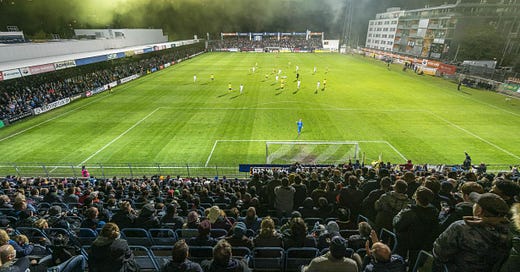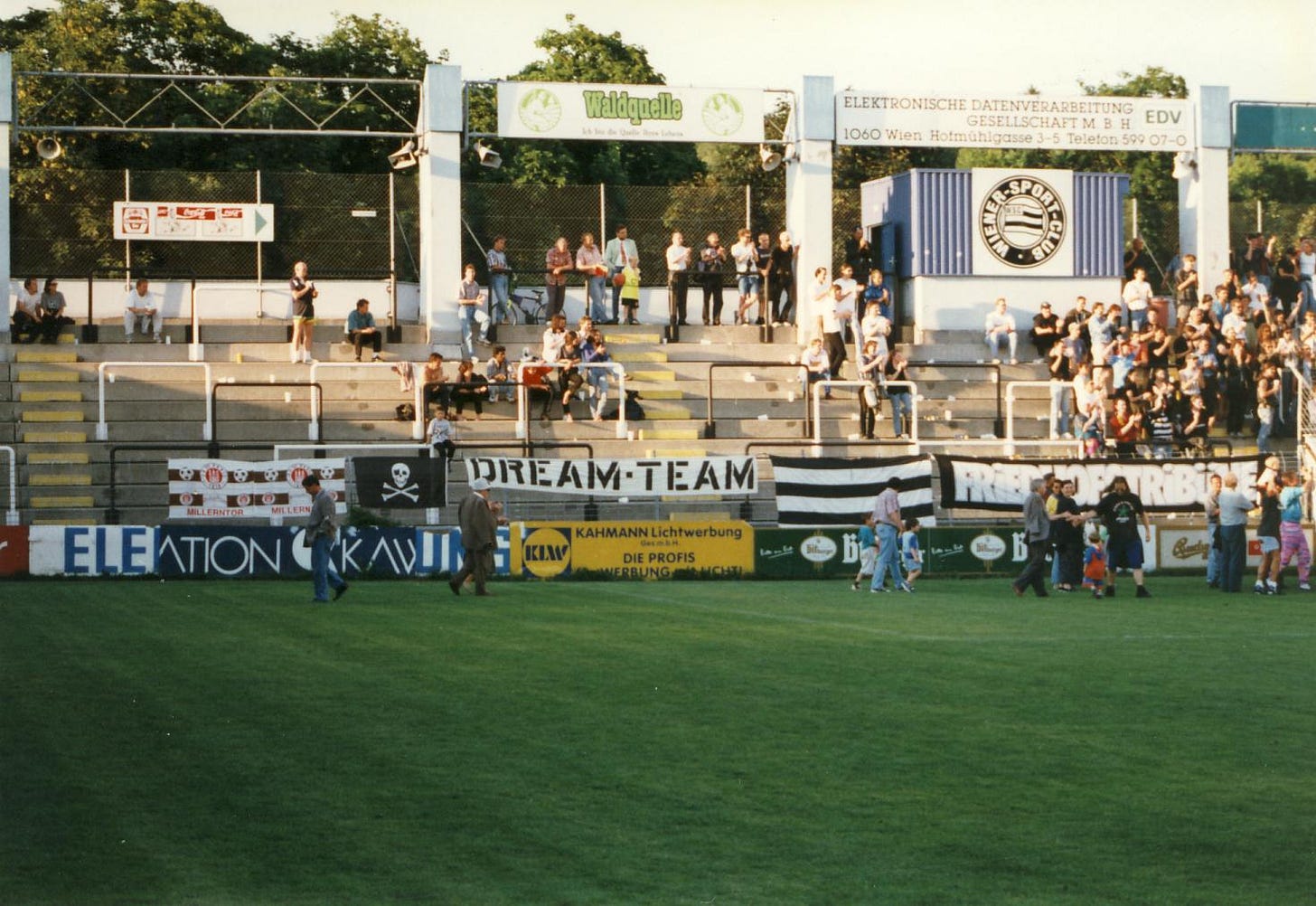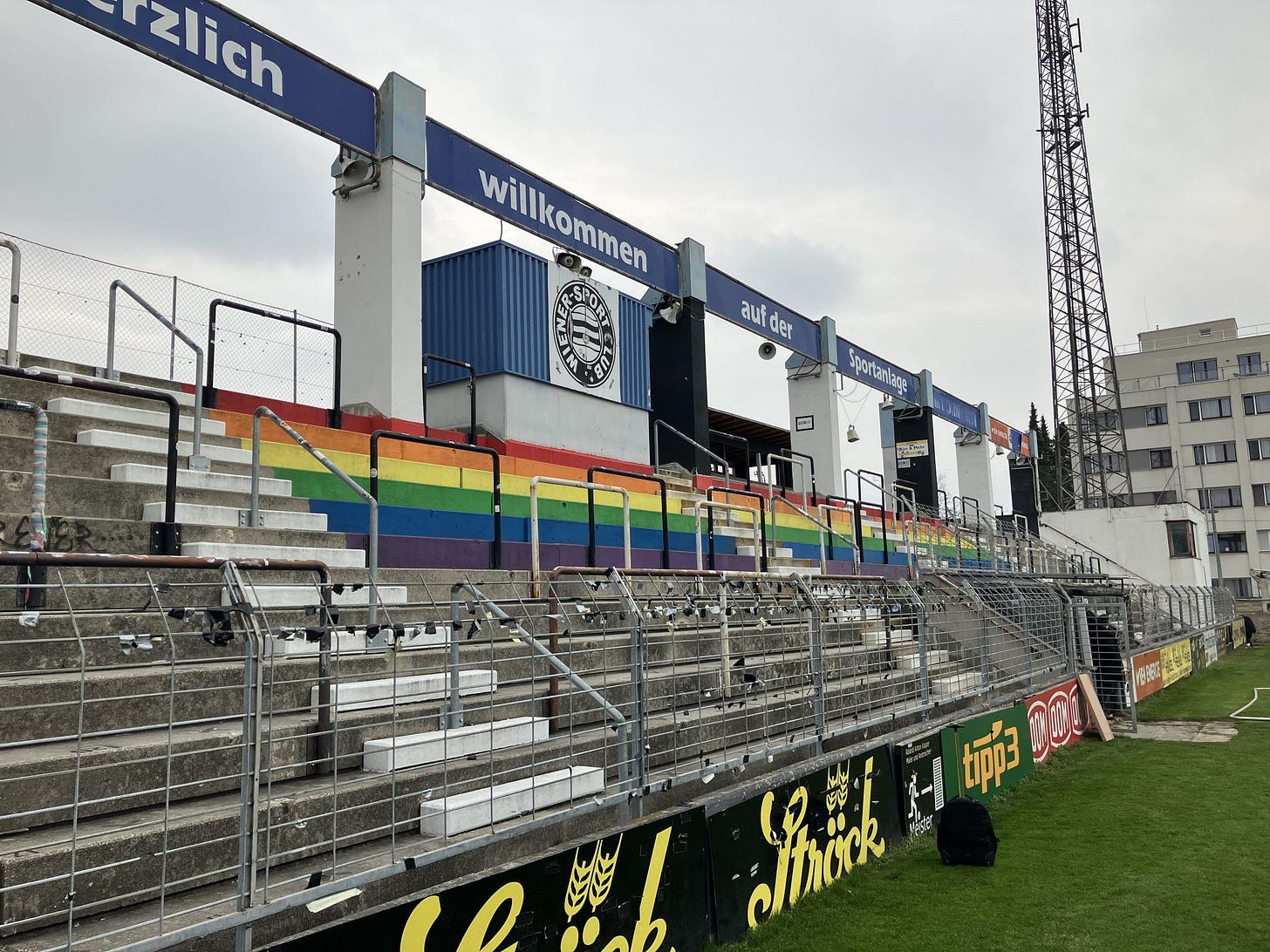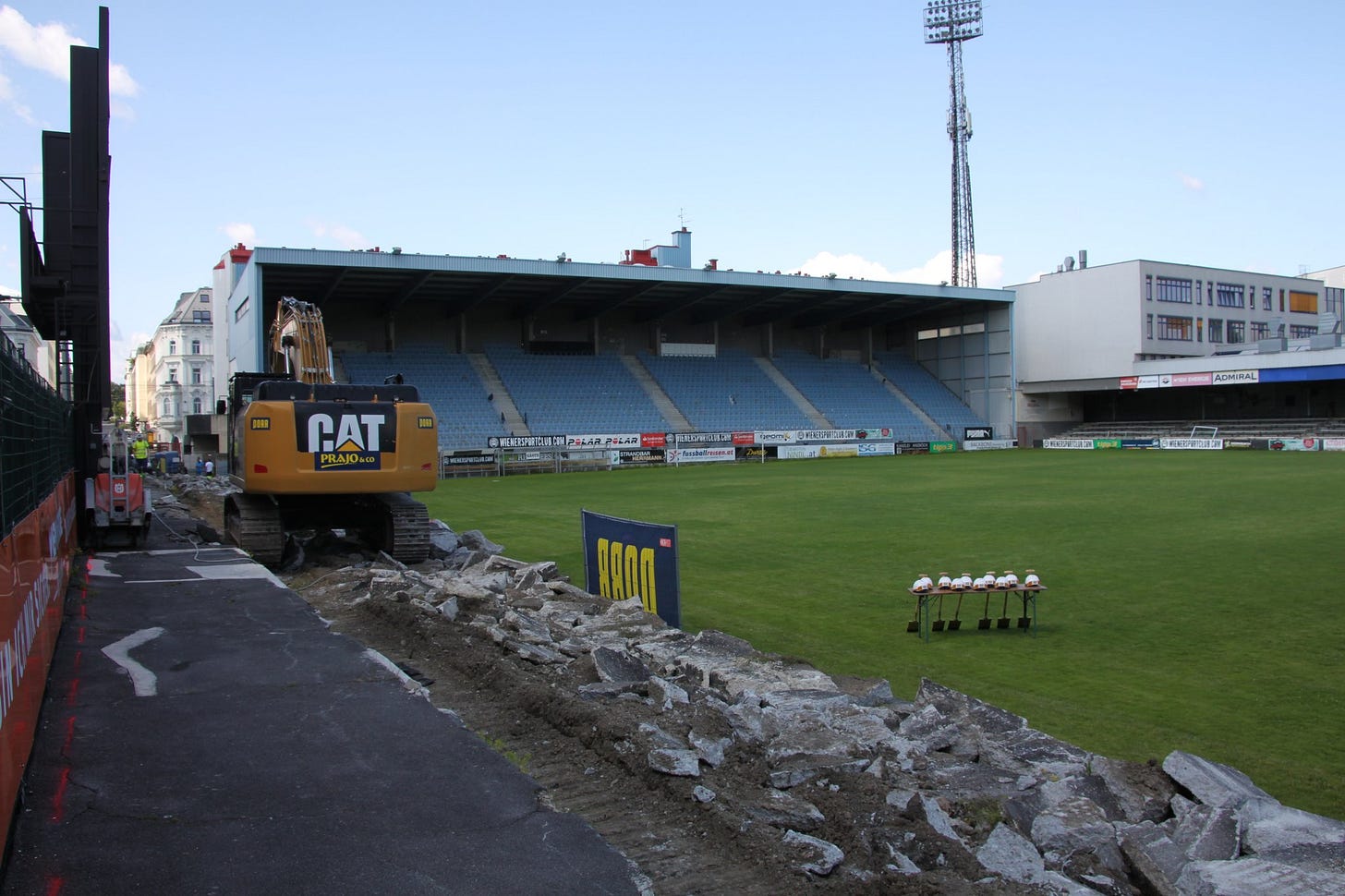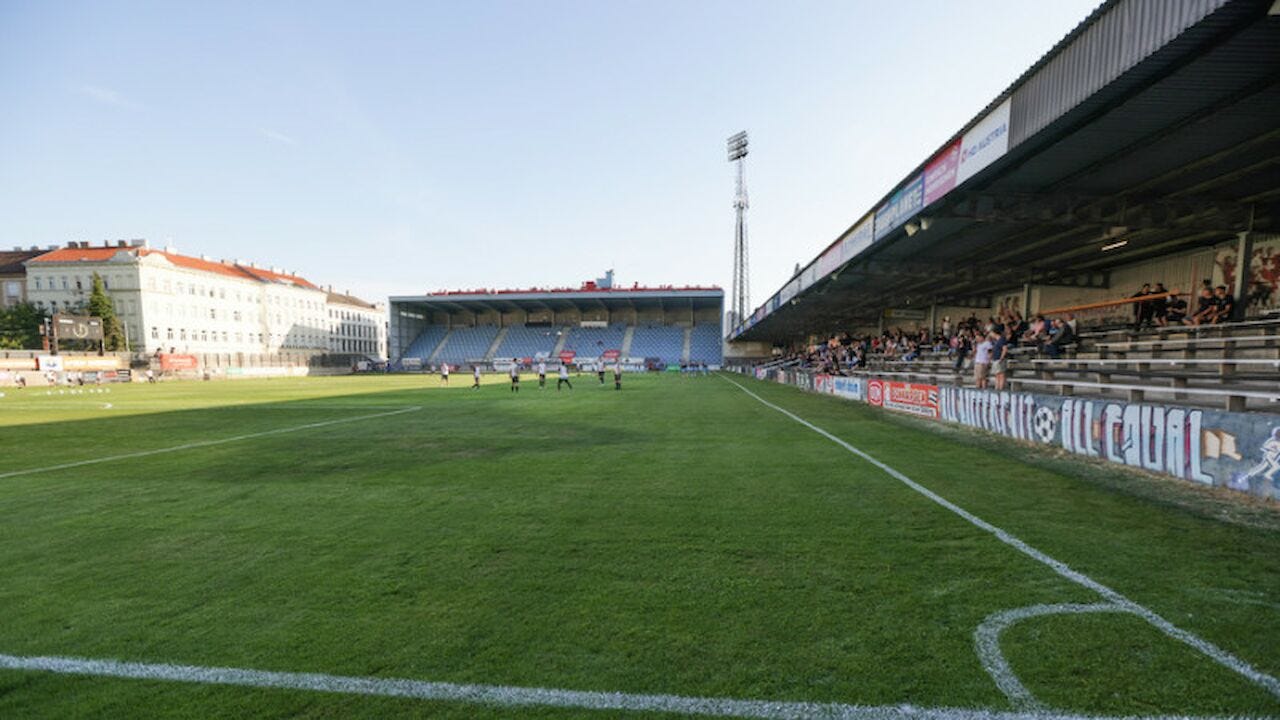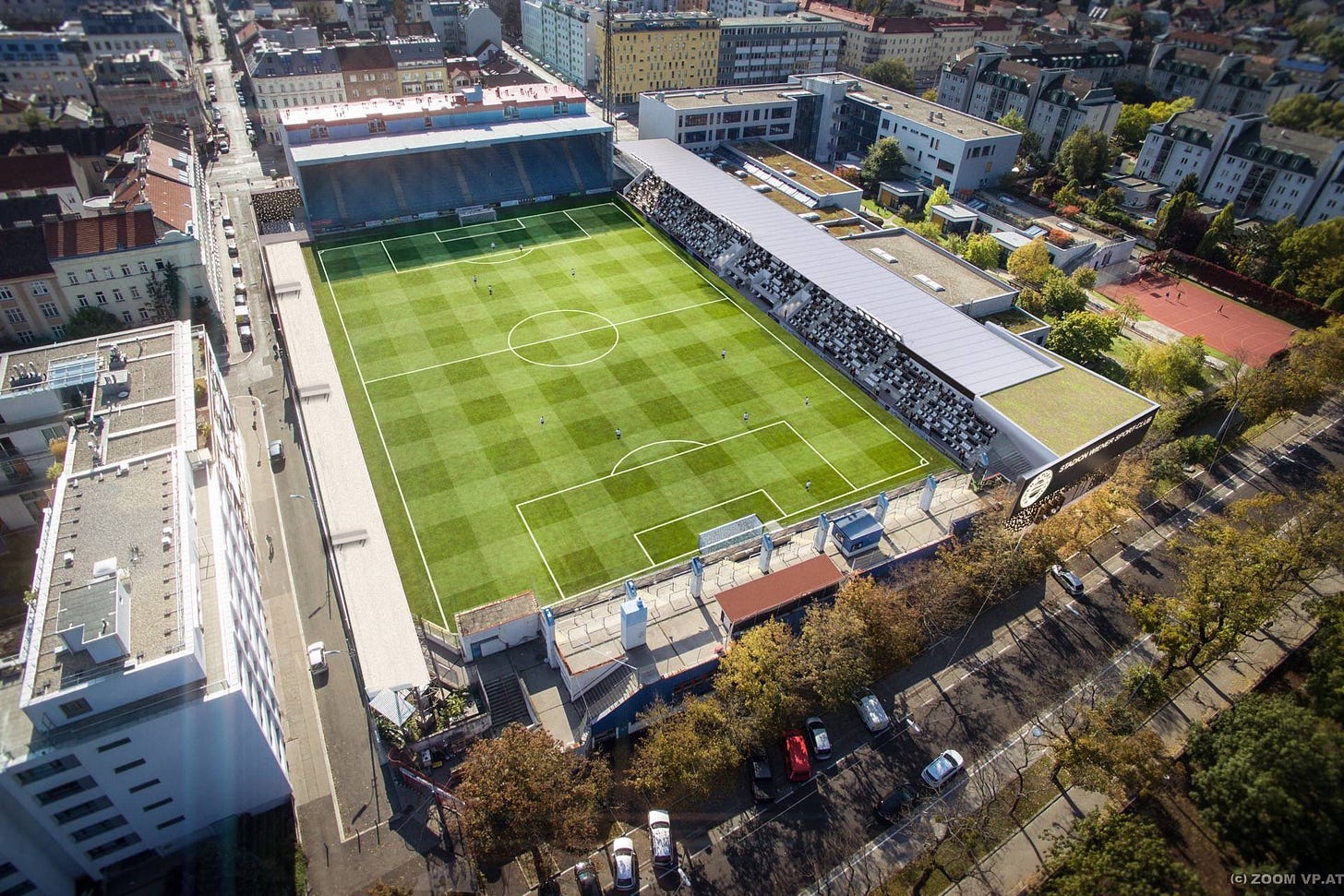SportClub Stadium (Wiener SportClub)
In which we experience a 'British' stadium and shake some keys
When I go abroad, I want to integrate myself with the country I’m visiting. Otherwise, what’s the point? I cannot understand the people who head off to the Costa del Sol and then head to an English bar to have sausage and chips, just like they’d do at home. At that point, you might as well just buy a sun lamp and go to Skegness. But I’ll admit, I have an interest in other countries doing British things. Like, how does a Spaniard try to cook various British staples? Like is there some extra paprika in the shepherd’s pie or do they use chorizo for bangers and mash? This can be the same for football. I love going abroad to watch football to see the different cultures that surround it, and how stadium design changes. But what if you go to something that is actively described as being very British? Well, let’s talk about SportClub Stadium, the homer of Wiener SportClub.
So, some quick backdrop to this, as I imagine many of you have seen the names in the title and wondering what the hell any of them are. Well firstly, Wiener SportClub. They are one of the oldest sports clubs in Austria, being founded in 1883. That’s the sports club itself by the way, as like a lot of European teams this isn’t all about football. Wiener also compete at a lot of other sports, but most of the other teams would be discontinued after the end of World War 2. The actual football team started in 1904, which still makes it one of the oldest football teams in Austria. In fact, it’s main rival is First Vienna, who are the oldest football team in Austria. They were once of the giants of Austrian football and very successful, especially when football in this country mostly revolved around the gazillion teams in Vienna. But over the years, they struggled with poor finances and now are in the third tier of Austrian football.
This is probably the hardest Stadium Report I’ve done, but not for any interesting reason. It’s just been very hard to research. The combination of a pretty vague name, being a lower level stadium in a country and a website that doesn’t go into the history makes it quite tricky to tell you the history of this ground. So, I can only tell you bits and pieces. About six months after the football section of Wiener SC formed, they were able to rent a sports field in the area of Dornbach, borrowing it off St Peter’s Abbey, a church in Salzburg. Why a church in Salzburg owned a field in Vienna is beyond me, but I feel like it’s probably Mozart’s fault. This would develop into the SportClub Stadium as it is today, but when things were built I have no idea. Honestly, it was hard enough to get the information I have now.
The match I was set to see was a home match against Elektra, and I would be seeing it a bit bleary eyed. I had been on an early flight to Vienna from London Gatwick, and my cheapness meant staying over night in the terminal rather than doing the sensible thing of booking a hotel room. So after checking into my very nice hotel, having a quick dinner at StrasserBrau, I took the tram to Dornbach. On the tram journey, you can just see the stadium poking out from behind the main street buildings. A short walk from the tram stop, and you’re at the ground. I met up with a couple of members from Planet Viola, an internationalist Austria Wien fan club which contains plenty of British expats who now live in Vienna. They were to be my education about Wiener, meaning I wouldn’t be totally lost.
There’s a social area just outside the Cemetery End, named as such because of the cemetery next to this stand, where there’s a bar, shop under a gazebo and someone frying some sausages, because this is Austria and that’s what they do. After a few beers outside, we went into the ground. I had a ticket for the main stand, which currently doesn’t have a roof, which will be a surprise to you the reader, as the pictures here show it has a roof. It is a fairly shallow stand, with wooden benches instead of seats. On the left and behind a goal is the Cemetery End, which is a concrete standing terrace. A rainbow is painted onto it to reflect the club’s support for the LGBT+ community. Behind it also houses the club’s offices and dressing rooms, and the players tunnel comes out of the middle of it. There is a traditional seated stand behind the other goal, while there is currently no stand on the other long side, though this is due to it being demolished for further renovations.
So, the Britishness. If you go on Wiener’s official website and on the stadium’s Wikipedia page, they mention that they offer a more British style experience. And you can see it. The seated stand to the right of the main stand is definitely very British. It looks like a mid-tier Championship side who’s converted their fans favourite terrace into a seater following the Taylor Report. You could easily take that stand and move it to somewhere like Preston North End or Blackburn Rovers without anyone taking much notice. But I think the Britishness refers more to the attitude of the fans in the Cemetery End. Typically, a lot of the passionate foreign fans fall into the ultra category, they repeatedly chant and sing, aided by a conductor at the front, and often it doesn’t follow the rhythm of the game. Wiener’s fans follow the British mold, there are moments of quiet but the chants follow the game, and react to what’s happening on the pitch. Obviously, it’s not all British. Being able to drink in the stand, the wooden benches and no roof to the stands is distinctly not something you’d be able to do in the United Kingdom. It’s like the foreign take on British food when they use ingredients you wouldn’t expect. I had fish and chips in Piraeus before seeing Olympiacos last year, and the way that was done felt like a mixture of Greek and British methods. This is the same, but football fans.
The game itself was very entertaining. Wiener started off the better, but their opponents TWL Elektra took the lead early on. Their first foray forward got them a corner, and it was headed in by Filip Drljepan to give the away side the league. It was when Wiener got a free kick at the other end when I discovered one of the home team’s traditions. Ahead of any set piece Wiener are taking, the fans get out their keys to shake them. This isn’t a unique tradition, it is also done at Danish giants FC Kobenhavn and also done at the American Football games of Northwestern College. A previous report on Wiener SC had saw the writer ask a fan on why they shake their keys, only to hear back ‘Why not?’. This is a very typical Viennese answer, to the point and leaving the listener in confusion to if the person is rude or not. I couldn’t find a clear answer on the internet anyway, but it’s something that adds character to the atmosphere.
Anyway, back to the game. Wiener were the better side and eventually got the goal they deserved. Felix Kerber headed from a cross and the game was level. Wiener continued to push for another goal and they have it before the end of the first half with Philip Buzuk scoring a neat little finish following a goalkeeper error. The second half was well contested but neither side could get a goal. Emmanuel Ojukwu was sent off for a second yellow at the end of the game, but I didn’t really notice. 2,000+ were in the ground for this game, but it was still an easy off. A short walk to the tram stop, and an easy, not at all crowded return to my hotel for some much needed sleep.
It’s worth mentioning a bit of a phenomenon you will only get a lower league games in Austria, and perhaps other countries that run a deposit scheme. In the main stand it was free seating and it was roomy enough to roam. And Wiener also run a deposit scheme for their cups, meaning you have to pay a Euro extra for the cup you’re having your beer in. But if you return the cup, you get the Euro back. It’s all about promoting sustainability and not creating a seal killings-worth amount of plastic from a match. I think some UK venues have it in place, but I wouldn’t be shocked if all of them had it at some point. But with the freedom to move around, it does encourage some sneaky, but remarkably clever kids. These kids will skulk about and if they spot any empty cups, they will snaffle them and make off with the proceeds. It’s canny and I respect it, but you do have to keep an eye on your cups if you want to get your Euro back!
I was told by one of my Planet Viola friends that I may have been at a special game. This is probably one of the last games Wiener SC play in this stadium in it’s current state. Plans to renovate the stadium so that it would be possible for the club to get into the Austrian Bundesliga have been around since 2018, but the pandemic had heavily delayed them. Vienna City Council have agreed to fund much of the renovations, and it will heavily change the stadium. The main stand will become completely modern, and the offices and dressing rooms will move there from the Cemetery End. I’ve seen various image mock-ups which all suggest something different though, which makes sense considering how long this has been in the works. Times change, and certainly the costs will have gone up since the original plans were made.
I just hope that the renovations don’t take away the character of the stadium. Because the SportClub Stadium is an absolute gem of a ground. It does need the renovations, it’s definitely battered, aged and run down in quite a lot of places. But it also feels very special and has character in bucket loads. It’s a very unique ground with each stand having it’s own story to tell, and it feels like an organic part of the city when nearby Viennese apartment blocks have people watching the game from their balconies. Vienna isn’t exactly the hot ticket for football trips, and if you go there and you want football you’ll probably look first at either Rapid or Austria Wien. But Wiener SC is a proper hidden gem that has to be seen.

